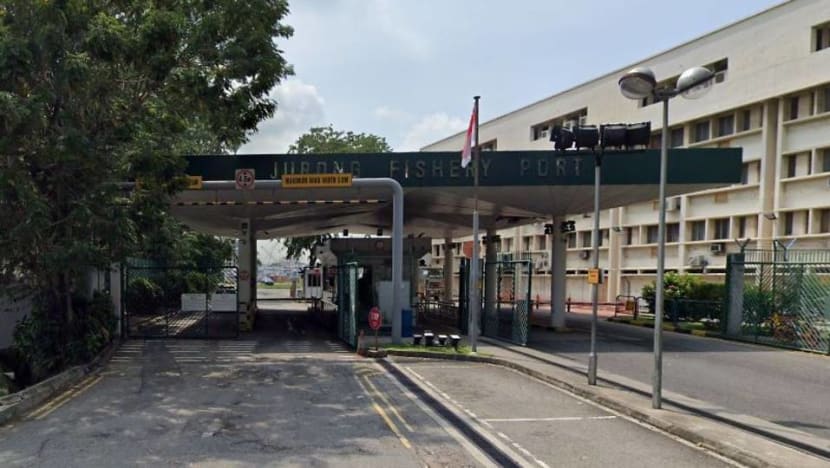Jurong Fishery Port cluster: No evidence of COVID-19 transmission through contaminated fish, says MOH

Jurong Fishery Port. (Photos: Google Street View)
SINGAPORE: There is no evidence to suggest that COVID-19 transmission occurred through contaminated fish, said director of medical services at the Ministry of Health (MOH) Kenneth Mak on Tuesday (Jul 20).
“We believe that the fish that we still consume and enjoy remain safe for consumption," said Associate Professor Mak as he provided details about the growing number of infections linked to Jurong Fishery Port.
There are 321 cases linked to the swelling cluster as of noon on Tuesday, and authorities expect more cases to be confirmed at the port and wet markets.
READ: Return to Phase 2 Heightened Alert: Dining-in to be suspended, group sizes back down to 2
READ: Return to tighter measures needed as COVID-19 infections likely to 'rise sharply' at current transmission rates: MOH
Speaking at a press conference by the COVID-19 multi-ministry task force, Assoc Prof Mak said phylogenetic testing done on the first group of cases detected at Jurong Fishery Port had found that the Delta variant is the cause of the COVID-19 cases in this cluster.
“The identified variant of concern has features that are similar to what we have seen in other cases that we have picked up in imported cases from Indonesia,” he added.
“So we believe that COVID-19 infection in this cluster has been introduced perhaps via a sea route into the fishery port, likely from Indonesian or other fishing boats that have brought fish into the port.”
Still, he said that the exact mechanism of transmission from the fishing boats to stall operators at the port “isn't entirely clear”.
While efforts have been made to make operations at the port “as contactless as possible”, Assoc Prof Mak noted that it is “very challenging” to maintain safe distancing measures due to the port’s hot and humid environment and nature of activities like the carrying of heavy barrels of fish and ice.
Some mask-off activities and close interactions between people would likely have taken place.
"Formite transmission on contaminated surfaces and at the stalls remains a strong possibility for transmission," he added.
READ: TraceTogether check-in to be mandatory at all wet markets and hawker centres in Singapore
READ: Singapore, Hong Kong to review travel bubble when COVID-19 situation allows: MOT
“MULTIPLE EPISODES OF INTRODUCTION”
A phylogenetic test also suggests that the clusters linked to the port and several wet markets “may not have been due to a single point of introduction of infection”, said Assoc Prof Mak.
“Indeed, exposure may have occurred over a period of time with multiple points of injection of infection,” he said, explaining that this is because the genetic information for variants identified so far “are not completely identical across the different cases”.
“They do reflect a common parentage but there are subtle differences in the individual test results to suggest that it's instead multiple episodes of introduction having occurred,” said Assoc Prof Mak.
“And so we are not able to determine how long these episodes of introduction have occurred over, and who might have been a specific super-spreader leading to the larger cluster that has emerged right now.”
It is also not possible for authorities to identify a specific case and say that this was the case that led to transmission from the boats to the fishery port, and from the port to wet markets across Singapore, he added.
“In the contact tracing that we’ve done, together with the epidemiological investigations to date, we have identified potential nexus of activity shared across the different clusters.”
READ: KTV and Jurong Fishery Port COVID-19 clusters are 'linked': Ong Ye Kung
READ: MINDEF reviewing scale of National Day Parade and COVID-19 measures: Lawrence Wong
For example, at least one COVID-19 case who worked at Jurong Fishery Port frequented a KTV lounge within the infectious period.
“It is, however, not possible for us to verify whether that individual did transmit an infection because the diagnostic PCR test performed on that individual detected the presence of COVID-19 virus, but it was at a very low count,” said Assoc Prof Mak, adding that this “very low viral load” means insufficient virus to carry out phylogenetic testings.
“From the public health perspective, it is less important for us to confirm that link between the Fishery Port and the KTV lounge,” he added.
“Irrespective of how transmission has taken place, there are cases and growing clusters in each setting, and the numbers of cases that we are picking up from the wet market testing continue to grow, and this remains a cause for concern.”
Assoc Prof Mak also pointed out that COVID-19 outbreaks have taken place in wet markets overseas. These include the first reported coronavirus case in Wuhan, China, as well as others in Thailand, Sri Lanka and Europe.
“This is an area where we will continue to work closely with our partner sector-leads to review the safe measure protocols in place, and to review the need for routine regular testing to detect infections early in these settings and to disrupt potential chains of transmission,” he said.
BOOKMARK THIS: Our comprehensive coverage of the COVID-19 pandemic and its developments
Download our app or subscribe to our Telegram channel for the latest updates on the coronavirus outbreak: https://cna.asia/telegram












